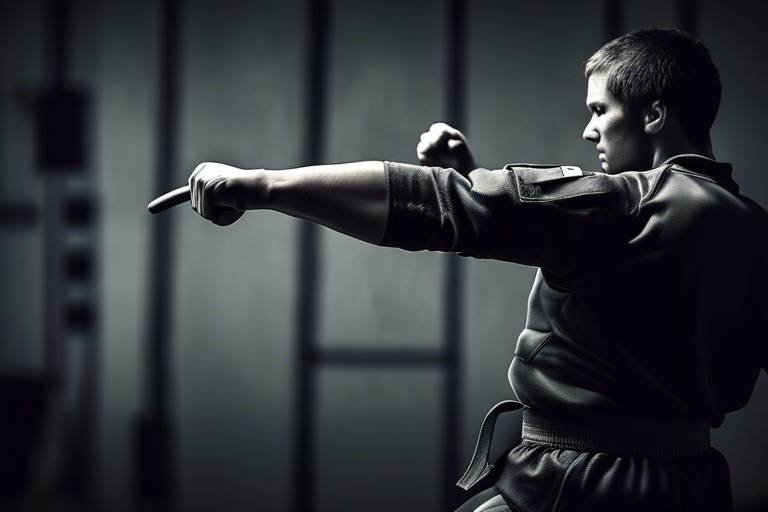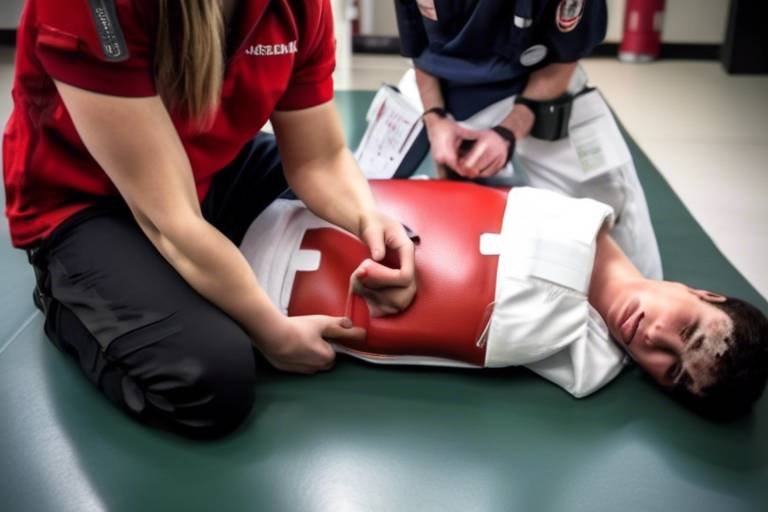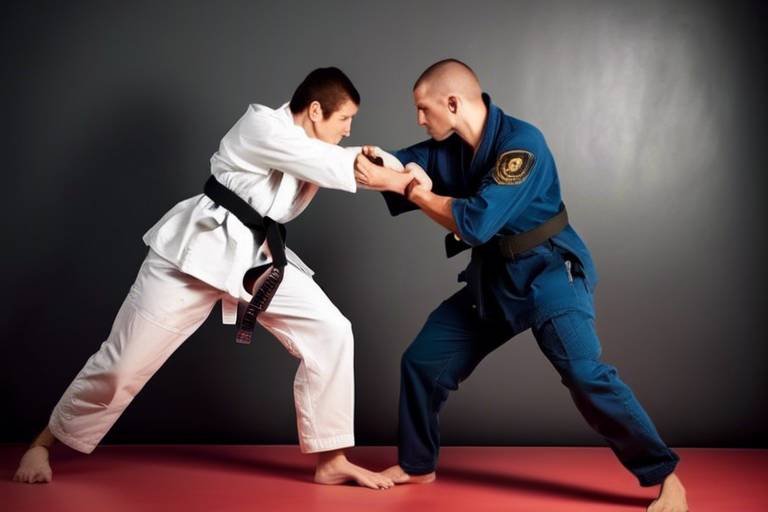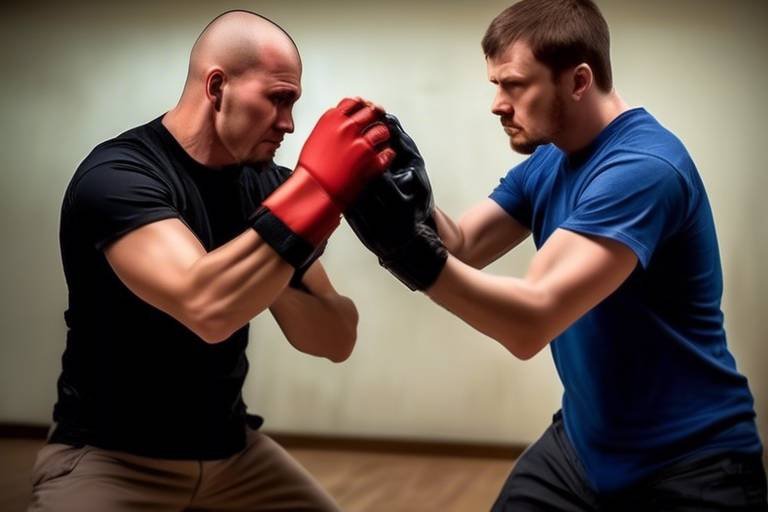Gamification in Self-Defense Training - Does it Work?
In today's fast-paced world, the concept of self-defense has evolved beyond mere physical skills; it's about mindset, strategy, and, increasingly, engagement. Enter gamification, a buzzword that has taken various industries by storm, including education and fitness. But what happens when you combine this innovative approach with self-defense training? Does it really make a difference? In this article, we'll dive deep into the effectiveness of gamification in self-defense training, exploring its benefits, potential drawbacks, and how it can create a more engaging learning experience for participants.
Imagine walking into a self-defense class, not just to learn how to throw punches or execute a perfect kick, but also to play a game that challenges your reflexes and sharpens your instincts. This is the magic of gamification—integrating game-like elements into training contexts to enhance motivation and engagement. Think of it as transforming a traditional learning environment into an interactive battlefield where every move counts, and every decision could lead to victory or defeat. It's not just about learning techniques; it's about mastering them in a fun and dynamic way.
As we explore the various aspects of gamification in self-defense training, we will uncover how this method can lead to improved retention of skills, increased participant engagement, and a more enjoyable learning atmosphere. However, like any revolutionary approach, it comes with its own set of challenges and limitations. So, let's embark on this journey and see if gamification is indeed a game-changer in the realm of self-defense training.

The Concept of Gamification
Gamification is a buzzword that has taken the training world by storm, but what does it really mean? At its core, gamification involves the integration of game-like elements into non-game contexts. Think of it as adding a sprinkle of fun to the serious business of learning. By incorporating aspects like points, badges, leaderboards, and challenges, trainers can transform mundane tasks into engaging experiences that captivate and motivate participants.
Now, you might be wondering how this applies specifically to self-defense training. Well, imagine a scenario where you’re not just learning techniques but also competing with friends, earning badges for mastering moves, or even leveling up your skills. This is where gamification shines—it not only makes the training sessions more enjoyable but also enhances the overall learning experience. Participants are more likely to retain information and apply it effectively when they are actively engaged in the process.
To illustrate the relevance of gamification in self-defense training, consider the following key elements:
- Engagement: Gamification keeps learners interested and involved, which is crucial in a subject as intense as self-defense.
- Motivation: By setting goals and offering rewards, participants are driven to improve their skills and knowledge.
- Community: Gamified environments often foster a sense of camaraderie among participants, making them more likely to support and learn from each other.
In summary, gamification in self-defense training is not just about making things fun; it’s about creating an environment where learners can thrive. By leveraging the principles of gaming, trainers can enhance retention, boost motivation, and foster a collaborative spirit among participants. So, the next time you step into a self-defense class, remember that there’s a game afoot, and you’re not just a participant—you’re a player in your own learning adventure!

Benefits of Gamification in Training
Gamification has emerged as a game-changer in various training environments, particularly in self-defense training. By incorporating game-like elements, trainers can create an engaging atmosphere that motivates participants to learn and practice essential skills. One of the most significant benefits of gamification is its ability to enhance retention. When learners are actively involved in their training through interactive challenges and rewards, they are more likely to remember what they have learned. This is akin to how children learn through play; the more engaged they are, the more they absorb.
Another key advantage is the boost in engagement. Traditional training methods can often feel monotonous, leading to disengagement and lackluster performance. However, gamified training transforms the learning experience into an exciting adventure. Imagine a self-defense class where participants earn points for successfully completing drills or mastering new techniques. This not only makes the training more enjoyable but also fosters a sense of community among participants as they share their achievements and support each other.
Moreover, gamification can improve the application of skills. In a gamified environment, learners are encouraged to apply their knowledge in real-time scenarios, which can help them develop muscle memory and confidence. For instance, a self-defense program might include simulation exercises where participants face off against opponents in a controlled setting. This hands-on approach allows learners to practice their techniques under pressure, preparing them for real-life situations.
Research supports these benefits, showing that gamified training can lead to higher completion rates and better performance outcomes. A study conducted by the University of Colorado found that participants in gamified training programs demonstrated a 20% increase in knowledge retention compared to those in traditional formats. This is a compelling statistic that underscores the effectiveness of gamification in enhancing learning experiences.
To illustrate these benefits further, consider the following table that summarizes the key advantages of gamification in self-defense training:
| Benefit | Description |
|---|---|
| Retention | Enhances memory and recall of techniques through interactive learning. |
| Engagement | Increases participant involvement and enjoyment during training. |
| Application | Encourages practical use of skills in realistic scenarios. |
| Community Building | Fosters camaraderie among participants through shared goals and achievements. |
In conclusion, the benefits of gamification in self-defense training are multifaceted and impactful. By creating a dynamic learning environment, trainers can not only improve retention and engagement but also facilitate the practical application of skills. As more self-defense programs adopt gamified approaches, we can expect to see a generation of learners who are not only better prepared but also more enthusiastic about their training journey.

Challenges and Limitations
While gamification in self-defense training offers a plethora of benefits, it is not without its . One of the primary concerns is the potential for an overemphasis on competition. In a gamified environment, participants may become more focused on winning points or achieving higher scores rather than mastering essential self-defense techniques. This shift in focus can lead to a superficial understanding of the skills required, as learners might prioritize flashy moves or strategies that yield immediate rewards over fundamental techniques that are crucial for real-world situations.
Moreover, there is a risk of trivializing what is inherently a serious subject. Self-defense is about personal safety and protection, and when elements of fun and games are introduced, some participants may not fully appreciate the gravity of the skills they are learning. This could potentially lead to a lack of seriousness in training sessions, where the focus shifts from practical application to merely having fun. It's essential to strike a balance between engagement and the seriousness of the content being taught.
Another limitation is the diversity of learning styles among participants. Not everyone responds positively to gamified learning. Some individuals may prefer traditional training methods that allow for deeper contemplation and practice of techniques without the pressure of competition. This can create a divide in training effectiveness, where some learners thrive in a gamified setting while others may feel alienated or overwhelmed.
Additionally, the implementation of gamification requires careful planning and resources. Developing a well-structured gamified program can be time-consuming and may require investment in technology or training materials. Smaller self-defense schools or programs may struggle to allocate the necessary resources, which could limit their ability to adopt gamification effectively.
Finally, there is the challenge of measuring success. While gamification can enhance engagement, determining the actual impact on skill development and retention can be complex. Traditional metrics may not adequately capture the nuances of learning in a gamified environment, leading to a reliance on subjective assessments rather than objective data.
In summary, while gamification has the potential to revolutionize self-defense training, it is crucial to remain aware of its challenges and limitations. Addressing these concerns through thoughtful design and implementation can help ensure that the benefits of gamification are fully realized without compromising the integrity of the training.
- What are the main challenges of gamification in self-defense training? The main challenges include overemphasis on competition, trivialization of serious techniques, varying learning styles, resource allocation for program development, and measuring success effectively.
- Can gamification be effective for all learners? No, gamification may not resonate with every participant. Some individuals might prefer traditional training methods that focus on technique mastery.
- How can trainers balance gamification with serious training? Trainers can maintain a balance by integrating gamified elements while emphasizing the importance of mastering fundamental self-defense skills.

Case Studies of Successful Implementation
When it comes to gamification in self-defense training, real-world examples can illuminate the path forward, showcasing how integrating game-like elements can lead to substantial improvements in learning outcomes. One notable case is the Women's Self-Defense Program implemented at a community center in Chicago. This program incorporated gamified elements such as point systems for participation, level progression for skill mastery, and team-based challenges that fostered camaraderie among participants. Feedback from participants revealed that the competitive aspects of the training not only made the sessions more enjoyable but also increased their commitment to learning essential self-defense techniques.
Another compelling example is the Self-Defense Academy in San Francisco, which utilized a mobile app to gamify their training curriculum. The app featured interactive challenges, quizzes, and video tutorials that participants could access outside of class. By earning badges for completing tasks and achieving specific milestones, learners were motivated to practice more frequently. A survey conducted post-program indicated that 85% of participants felt more confident in their abilities compared to when they started, illustrating the effectiveness of gamification in enhancing skill retention and application.
In addition to these examples, a study conducted by the University of Southern California analyzed various self-defense programs across the country. The findings revealed that programs that incorporated gamified elements saw a 30% increase in participant engagement and a 40% improvement in skill retention compared to traditional training methods. This study not only underscores the potential of gamification but also provides a roadmap for future programs aiming to enhance their effectiveness.
| Program Name | Location | Gamified Elements | Participant Feedback |
|---|---|---|---|
| Women's Self-Defense Program | Chicago | Point systems, level progression, team challenges | Increased enjoyment and commitment |
| Self-Defense Academy | San Francisco | Mobile app, challenges, badges | 85% felt more confident |
| USC Study | Various | Gamification in various programs | 30% increase in engagement, 40% improvement in retention |
These case studies demonstrate that the integration of gamification in self-defense training is not just a trend but a transformative approach that can lead to more effective and engaging learning experiences. By observing how different programs have successfully implemented gamified elements, other trainers and organizations can glean valuable insights into how to structure their own training initiatives. The key takeaway is that when participants are actively engaged and motivated, they are more likely to absorb and apply the skills necessary for self-defense.
Q1: What is gamification in self-defense training?
A1: Gamification in self-defense training involves incorporating game-like elements such as point systems, challenges, and rewards to enhance engagement and motivation among participants.
Q2: How can gamification improve skill retention?
A2: By making training more interactive and enjoyable, gamification encourages participants to practice more frequently, which can lead to better retention of skills and techniques.
Q3: Are there any drawbacks to using gamification in self-defense training?
A3: Yes, potential drawbacks include an overemphasis on competition, which may trivialize the seriousness of self-defense techniques, and the risk of disengaging those who are less competitive.
Q4: Can technology enhance gamified self-defense training?
A4: Absolutely! Technology such as mobile apps, virtual reality, and online platforms can provide additional resources and interactive experiences that enhance the overall training process.

Designing an Effective Gamified Program
Creating a successful gamified self-defense training program is akin to crafting a delicious recipe; it requires the right ingredients, a dash of creativity, and a clear understanding of your audience. First and foremost, you need to define your objectives. What do you want your participants to achieve? Is it improved retention of techniques, increased confidence, or perhaps enhanced physical fitness? Setting clear goals allows you to tailor your gamification elements effectively.
Next, consider the game mechanics that will engage your learners. Think of incorporating elements such as points, badges, leaderboards, and challenges. These components not only make the training more enjoyable but also foster a sense of competition and achievement among participants. For instance, you could award points for completing specific tasks or mastering techniques, which can motivate learners to push themselves further. A simple table below illustrates potential game mechanics:
| Game Mechanic | Description |
|---|---|
| Points | Earned for completing tasks or mastering skills. |
| Badges | Visual representation of achievements. |
| Leaderboards | Ranking system to encourage friendly competition. |
| Challenges | Specific tasks that participants must complete to earn rewards. |
Moreover, participant feedback mechanisms are crucial in this design process. Regularly collecting feedback allows you to adjust the program based on what works and what doesn’t. You might implement surveys or informal discussions post-training sessions to gather insights. This feedback loop not only helps improve the training experience but also shows participants that their opinions matter, increasing their engagement.
Another essential aspect is to ensure that the gamified elements do not overshadow the core self-defense techniques. While competition can be exciting, it's vital to maintain a focus on the seriousness of self-defense training. A balanced approach will help participants appreciate the skills they're acquiring while enjoying the gamified experience. Think of it as a dance; both partners need to be in sync for the performance to be successful.
Finally, remember to incorporate a variety of activities that cater to different learning styles. Some participants may thrive in competitive environments, while others might prefer collaborative challenges. By offering a mix of activities, you ensure that everyone can find their rhythm and engage fully in the training. This diversity can include:
- Individual challenges that focus on personal skill development.
- Team-based activities that encourage collaboration and camaraderie.
- Scenario-based training that simulates real-life situations.
In summary, designing an effective gamified self-defense training program involves a thoughtful blend of clear objectives, engaging game mechanics, regular feedback, and a focus on inclusivity. By paying attention to these elements, you can create a dynamic learning environment that not only teaches vital self-defense skills but also keeps participants motivated and engaged throughout their journey.
Q: What is the primary goal of gamification in self-defense training?
A: The primary goal is to enhance engagement and retention of self-defense techniques while making the learning process enjoyable and motivating for participants.
Q: How do I ensure the gamified elements do not trivialize self-defense?
A: It’s crucial to maintain a balance between fun and seriousness. Ensure that while gamification adds excitement, the focus remains on mastering essential self-defense skills.
Q: Can gamification be applied to online self-defense training?
A: Absolutely! Gamification can be effectively integrated into online platforms through interactive modules, quizzes, and virtual challenges, making self-defense training accessible to a broader audience.

Technology's Role in Gamification
In today's digital age, technology is not just a tool; it's a game-changer, especially in the realm of gamification. When we think about self-defense training, the integration of technology can not only enhance the learning experience but also make it more engaging and effective. Imagine stepping into a training environment where your skills are tested in real-time through virtual simulations or interactive mobile applications. This is the future of self-defense training, and technology is at the forefront of this transformation.
One of the most exciting aspects of technology in gamification is the use of mobile applications. These apps are designed to turn learning into a fun and engaging experience. They often include features like progress tracking, skill challenges, and even community leaderboards. This not only encourages participants to improve but also fosters a sense of community among learners. For instance, a self-defense app might allow users to compete against each other in virtual sparring matches, earning points and badges for their achievements. This approach makes learning feel less like a chore and more like a game, which can significantly boost motivation.
Moreover, virtual reality (VR) is revolutionizing how we approach self-defense training. With VR, participants can immerse themselves in realistic scenarios that simulate real-world threats. This technology provides a safe space for learners to practice their skills without the fear of real-life consequences. Imagine being able to face a virtual attacker and respond with the techniques you've learned. The adrenaline rush, combined with the realistic setting, can enhance muscle memory and reaction times, making the training much more effective.
Another exciting innovation is the use of online platforms that facilitate remote training. These platforms often include interactive video tutorials, live-streamed classes, and forums for discussion. Participants can engage with instructors and peers from anywhere in the world, breaking down geographical barriers. This accessibility means that more people can benefit from high-quality self-defense training, regardless of their location. Furthermore, online platforms can incorporate gamified elements like quizzes and challenges that allow participants to test their knowledge and skills in a fun way.
However, while technology brings many benefits, it also requires careful consideration. Not all learners have the same level of comfort with technology, and some may find it overwhelming. Therefore, it's essential to create a balance between traditional teaching methods and technological integration. Additionally, trainers must ensure that the gamified elements do not overshadow the core principles of self-defense. The goal is to enhance learning, not to trivialize the seriousness of the techniques being taught.
In summary, technology plays a pivotal role in the gamification of self-defense training. By leveraging mobile apps, virtual reality, and online platforms, trainers can create a more engaging and effective learning environment. As we move forward, it will be fascinating to see how these technologies evolve and continue to shape the future of self-defense training.
- What is gamification? Gamification is the integration of game-like elements into non-game contexts to enhance engagement and motivation.
- How does technology enhance gamification in self-defense training? Technology enhances gamification by providing interactive platforms, virtual simulations, and mobile apps that make learning more engaging.
- Can anyone participate in gamified self-defense training? Yes, gamified self-defense training is designed to be accessible to people of all skill levels, making it easier for everyone to learn.
- What are some examples of technology used in gamification? Examples include mobile applications, virtual reality simulations, and online training platforms.

Measuring Success in Gamified Training
When it comes to gamified self-defense training, measuring success is not just about counting the number of participants who showed up or how many high scores were achieved. Instead, it involves a comprehensive approach that evaluates engagement, skill development, and overall satisfaction. Think of it like a fitness tracker for your training program; just as you wouldn't rely solely on the number of steps taken, you shouldn't base success on superficial metrics alone.
One effective way to gauge success is through participant feedback. Surveys can be a goldmine of information, providing insights into what participants enjoyed, what they found challenging, and how they believe the training could improve. You might ask questions like:
- How engaging did you find the gamified elements?
- Did you feel more motivated to learn self-defense techniques?
- What specific skills do you feel you improved upon?
Another critical aspect is skill assessment. Regular testing can help measure how well participants are applying what they've learned. For instance, you could implement scenario-based evaluations where participants must demonstrate their skills in a controlled environment. This method not only assesses their abilities but also reinforces learning through practical application.
Moreover, tracking progress over time is essential. By comparing pre-training and post-training assessments, you can quantify improvements in skills and knowledge retention. For example, if participants score significantly higher in self-defense techniques after completing a gamified program, it’s a clear indicator that the training was effective. A simple table can help illustrate this progress:
| Participant | Pre-Training Score | Post-Training Score | Improvement |
|---|---|---|---|
| John Doe | 60 | 85 | 25% |
| Jane Smith | 55 | 80 | 25% |
| Emily Johnson | 70 | 90 | 20% |
Additionally, analyzing engagement metrics from the gamification platform can provide valuable insights. Metrics such as participation rates, time spent on tasks, and completion rates can help you understand how involved participants are in their learning journey. If people are consistently dropping out at a particular level, it might indicate that the content is either too challenging or not engaging enough.
Lastly, it’s vital to create an environment where participants feel comfortable sharing their experiences. A culture of open communication can lead to valuable insights that numbers alone may not reveal. By fostering a space where individuals feel their voices matter, you can continuously refine your training program based on real feedback.
In conclusion, measuring the success of gamified self-defense training is multifaceted. It requires a blend of quantitative data, qualitative feedback, and an understanding of participant experiences. By focusing on engagement, skill application, and participant satisfaction, you can ensure that your training not only teaches essential techniques but also inspires confidence and enthusiasm among learners.
- What are the key metrics for measuring success in gamified training? Key metrics include participant engagement, skill assessment scores, and participant feedback.
- How can I gather participant feedback effectively? Surveys and open discussions can help gather valuable insights from participants about their training experience.
- What role does technology play in measuring success? Technology can provide analytics on engagement and participation, helping trainers understand how well the program is working.

Future Trends in Gamification for Self-Defense
As we look ahead into the realm of self-defense training, it's clear that the integration of gamification is not just a passing trend but a transformative approach that is set to evolve dramatically. Imagine a training environment where participants are not just passive learners but active players in a dynamic learning experience. The future of gamification in self-defense training is brimming with potential innovations that can enhance engagement and effectiveness.
One of the most exciting trends is the increasing use of virtual reality (VR) and augmented reality (AR). These technologies can create immersive environments that simulate real-life scenarios, allowing trainees to practice self-defense techniques in a safe yet realistic setting. Picture donning a VR headset and finding yourself in a crowded subway, where you must navigate through potential threats. This kind of training not only builds skills but also boosts confidence, as participants can rehearse their responses in a controlled environment.
Moreover, the rise of mobile apps is set to revolutionize how self-defense training is delivered. These apps can incorporate gamified elements such as challenges, leaderboards, and rewards for skill mastery. For instance, a self-defense app could present daily challenges, encouraging users to practice techniques and track their progress. This constant engagement can turn learning into a fun and rewarding experience, making it more likely that individuals will stick with their training.
Another noteworthy trend is the incorporation of social elements into gamified training programs. As humans, we thrive on connection and community. Future self-defense programs may leverage social platforms to foster a sense of camaraderie among participants. Imagine a scenario where trainees can share their achievements, participate in group challenges, and support each other in their learning journeys. This social interaction can enhance motivation and accountability, making the training process even more effective.
Additionally, the application of data analytics in gamified self-defense training is on the rise. By analyzing participant performance and engagement metrics, trainers can tailor programs to meet the specific needs of their students. For example, if data shows that a particular technique is consistently challenging for trainees, instructors can adjust their focus to provide additional support. This personalized approach not only improves learning outcomes but also ensures that each participant feels valued and understood.
Finally, as the world becomes increasingly digital, the potential for global collaboration in self-defense training is immense. Online platforms could enable trainees from different parts of the world to connect, learn, and compete in gamified challenges. This not only broadens the learning experience but also exposes participants to diverse perspectives and techniques, enriching their understanding of self-defense.
In conclusion, the future of gamification in self-defense training is bright and full of possibilities. With advancements in technology and a focus on community and personalized learning, we can expect to see programs that not only teach vital skills but also engage and inspire participants in unprecedented ways. As we embrace these trends, the journey to becoming adept in self-defense will transform from a mere necessity into an exhilarating adventure.
- What is gamification in self-defense training?
Gamification in self-defense training involves integrating game-like elements such as challenges, rewards, and competition to enhance learning and engagement.
- How does virtual reality enhance self-defense training?
Virtual reality creates immersive environments that simulate real-life situations, allowing trainees to practice techniques safely and effectively.
- Can mobile apps really improve self-defense skills?
Yes, mobile apps can provide interactive challenges and track progress, making training more engaging and motivating.
- Why is social interaction important in training?
Social interaction fosters community, motivation, and accountability, enhancing the overall training experience.
Frequently Asked Questions
- What is gamification in self-defense training?
Gamification in self-defense training refers to the incorporation of game-like elements into the learning process. This can include point scoring, competitions, and rewards to make training more engaging and enjoyable for participants. By turning serious learning into a more interactive experience, participants are often more motivated and focused.
- How does gamification improve learning outcomes?
Gamification enhances learning outcomes by increasing engagement, improving retention, and encouraging skill application. When learners are actively involved in their training through challenges and rewards, they tend to remember information better and apply their skills more effectively in real-life situations.
- Are there any drawbacks to using gamification in self-defense training?
Yes, while gamification has many benefits, it can also present challenges. For instance, an overemphasis on competition might lead participants to focus more on winning than on mastering important self-defense techniques. Additionally, there’s a risk that serious concepts could be trivialized, making it essential to strike a balance.
- Can you provide examples of successful gamified self-defense programs?
Sure! Various organizations have successfully implemented gamified self-defense training programs. For example, some martial arts schools use point systems and rankings to motivate students, while others incorporate technology like apps that track progress and offer rewards for achieving milestones.
- What key elements should be considered when designing a gamified program?
When designing a gamified self-defense program, it’s crucial to consider objectives, game mechanics, and participant feedback mechanisms. Clearly defined goals help maintain focus, while engaging game mechanics keep learners motivated. Additionally, incorporating feedback allows for continuous improvement of the training experience.
- How does technology enhance gamification in self-defense training?
Technology plays a vital role in enhancing gamification through tools like mobile apps, virtual reality, and online platforms. These technologies can create immersive experiences, track progress, and provide interactive challenges that elevate the training experience and make learning more effective.
- What metrics can be used to measure success in gamified training?
To measure success in gamified training, various metrics can be utilized, such as participant engagement levels, skill development assessments, and feedback surveys. Tracking progress through scores or levels can also indicate how well participants are absorbing the material and applying their skills.
- What are the future trends in gamification for self-defense training?
The future of gamification in self-defense training is likely to include even more advanced technologies, such as augmented reality and AI-driven personalization. These innovations could further tailor the training experience to individual needs, making learning more effective and enjoyable.



















